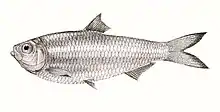| Escualosa thoracata | |
|---|---|
 | |
| illustration | |
| Scientific classification | |
| Domain: | Eukaryota |
| Kingdom: | Animalia |
| Phylum: | Chordata |
| Class: | Actinopterygii |
| Order: | Clupeiformes |
| Family: | Dorosomatidae |
| Genus: | Escualosa |
| Species: | E. thoracata |
| Binomial name | |
| Escualosa thoracata (Valenciennes, 1847) | |
| Synonyms | |
| |
The white sardine (Escualosa thoracata) is a species of fish in the family Clupeidae. It was described by Achille Valenciennes in 1847. It is a tropical fish of the Indo-Pacific distributed from Thailand to Indonesia and Australia.[2] Other common names include deep herring and northern herring.[3]
This species is amphidromous. It is known to swim at a maximum depth of 50 metres. The largest known standard length for the species is 10 cm.[2] It is distinguished from its sister species, Escualosa elongata, the slender white sardine, by its deeper body and broader silver band. The white sardine feeds on zooplankton and phytoplankton. It is a commercially important fish, used fresh and dried.[2]
References
- ↑ "Synonyms of Escualosa thoracata (Valenciennes, 1847)". fishbase.org.
- 1 2 3 Froese, R. and D. Pauly, Eds. Escualosa thoracata. FishBase. 2017.
- ↑ Escualosa thoracata. Fishes of Australia.
External links
This article is issued from Wikipedia. The text is licensed under Creative Commons - Attribution - Sharealike. Additional terms may apply for the media files.